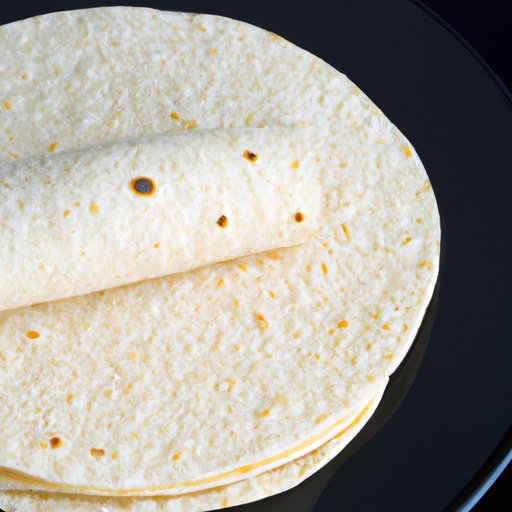Introduction
The debate between flour and corn tortillas has been ongoing for many years. Some people prefer the flavor and texture of flour tortillas, while others prefer the nutty taste and crunch of corn tortillas. But when it comes to health, which type of tortilla is better? In this article, we will explore this question in-depth by comparing the nutritional values of flour and corn tortillas, examining the health benefits associated with eating each type, and assessing the effects of different cooking methods and added ingredients on the healthiness of the finished product.
Body
I. Comparing the Nutritional Values of Flour and Corn Tortillas
When it comes to nutrition, both types of tortillas are relatively similar. On average, a single 6-inch flour tortilla contains around 120 calories, 2.5 grams of fat, 22 grams of carbohydrates, and 4 grams of protein. Meanwhile, a 6-inch corn tortilla contains about 80 calories, 1 gram of fat, 17 grams of carbohydrates, and 3 grams of protein. While there are some slight differences in calorie and fat content, both types of tortillas provide a good source of complex carbohydrates, as well as a decent amount of fiber and protein.
II. Exploring the Health Benefits of Each Type of Tortilla
In addition to providing essential nutrients like carbohydrates, fiber, and protein, both flour and corn tortillas contain a variety of vitamins and minerals that are important for overall health. For instance, flour tortillas are rich in thiamine, riboflavin, niacin, and folate, while corn tortillas are an excellent source of dietary fiber, magnesium, and manganese. Eating either type of tortilla can help boost your energy levels and promote healthy digestion.
Furthermore, research suggests that eating whole grain flour tortillas may reduce the risk of heart disease, diabetes, and obesity, while consuming corn tortillas may help protect against certain types of cancer. However, it’s important to note that these potential health benefits are largely dependent on how the tortillas are prepared and what ingredients are added.
III. Examining the Effects of Different Cooking Methods on the Nutritional Value of Tortillas
The way in which tortillas are cooked can have a significant impact on their nutritional value. For example, pan-frying a tortilla in oil can increase its fat and calorie content, while baking or steaming a tortilla can help retain more of its vitamins and minerals. Additionally, using high-quality ingredients such as fresh vegetables, lean meats, and low-fat cheeses can make a tortilla dish even healthier.
IV. Investigating Which Type of Tortilla Is Better for People With Dietary Restrictions
For people with specific dietary restrictions, such as those who are gluten-free or vegan, it’s important to consider which type of tortilla is better suited to their needs. Generally speaking, corn tortillas are the best choice for people with gluten allergies or sensitivities, as they do not contain any wheat-based ingredients. On the other hand, flour tortillas tend to be higher in calories and fat than corn tortillas, so they may not be the best option for people looking to lose weight or manage their blood sugar levels.
V. Assessing the Impact of Added Ingredients on the Healthiness of Tortillas
The healthiness of a tortilla dish also depends on the ingredients that are added. For instance, adding cheese, sour cream, butter, or other high-fat condiments can significantly increase the calorie and fat content of a tortilla dish. Similarly, using processed meats, such as bacon or sausage, can add unhealthy amounts of sodium and preservatives to a meal. To keep tortillas as healthy as possible, it’s important to use fresh, natural ingredients whenever possible.
VI. Analyzing the Differences Between Traditional and Modern Tortilla Recipes
Finally, it’s important to consider the differences between traditional and modern recipes used to make tortillas. While traditional recipes often include lard or shortening, which adds fat and calories to the finished product, modern recipes typically use vegetable oils, which are lower in saturated fats. Additionally, modern recipes often call for whole wheat flour, which is a healthier alternative to white flour. By using healthier ingredients, you can ensure that your tortillas remain as nutritious as possible.
Conclusion
Although both flour and corn tortillas offer numerous health benefits, there are slight differences between them that should be taken into consideration. When making a decision about which type of tortilla is healthier, it’s important to consider the nutritional value of each type, the health benefits associated with eating them, and the effects of different cooking methods and added ingredients on the healthiness of the finished product. Ultimately, choosing either type of tortilla can be a healthy addition to one’s diet, as long as it is prepared in a healthy manner.
(Note: Is this article not meeting your expectations? Do you have knowledge or insights to share? Unlock new opportunities and expand your reach by joining our authors team. Click Registration to join us and share your expertise with our readers.)
